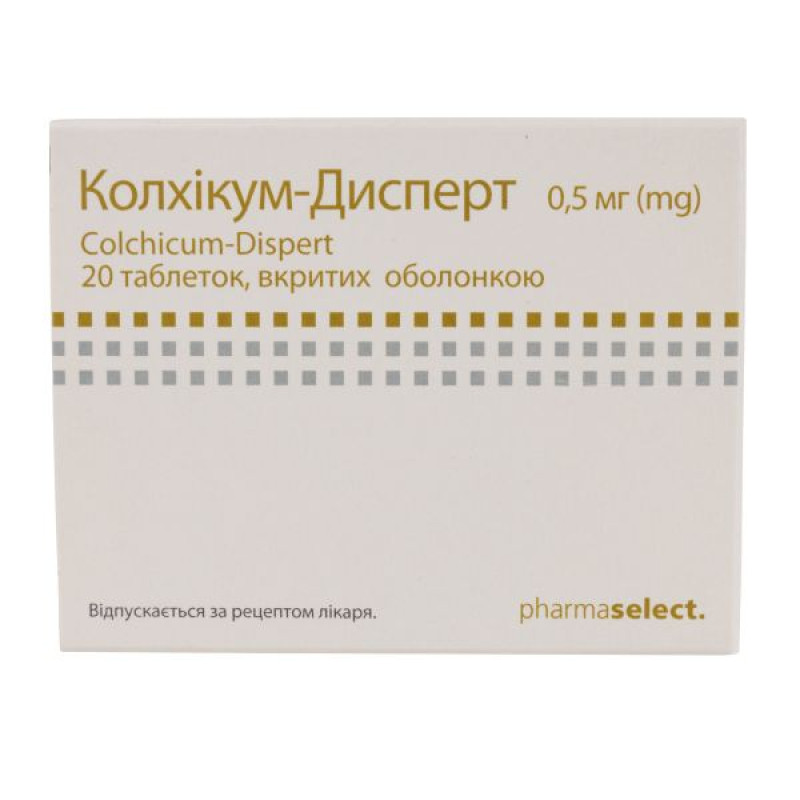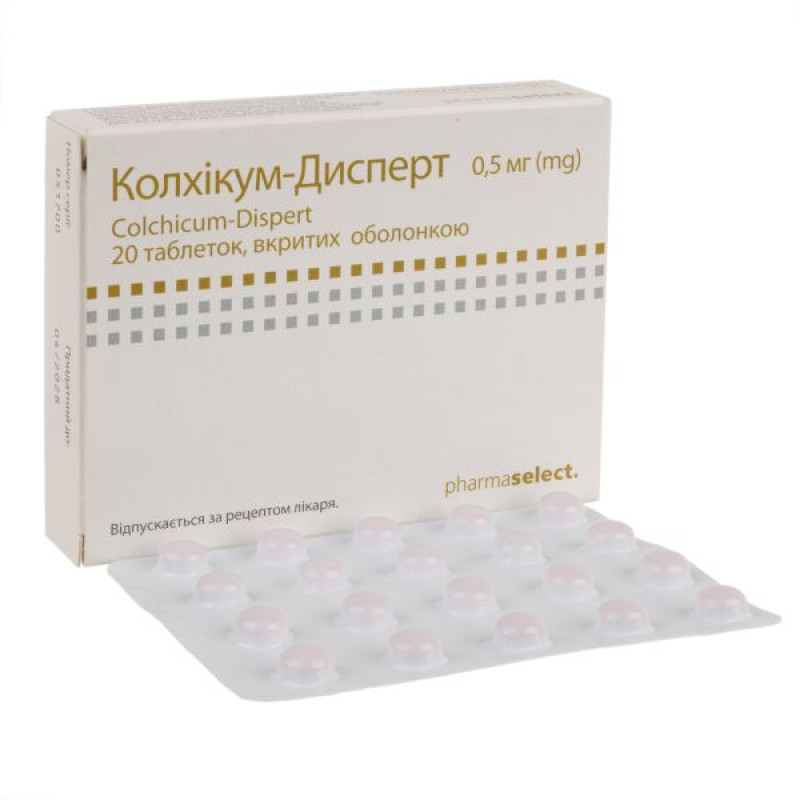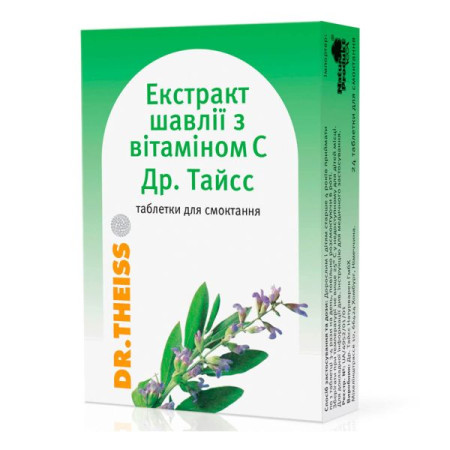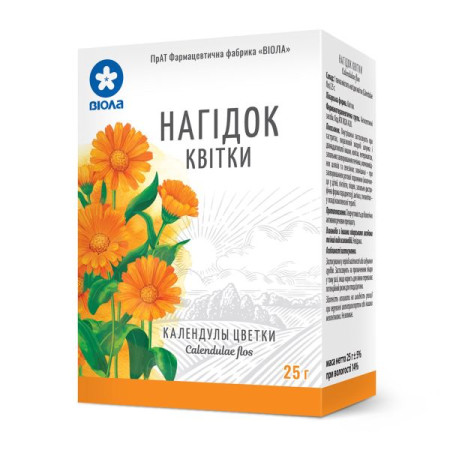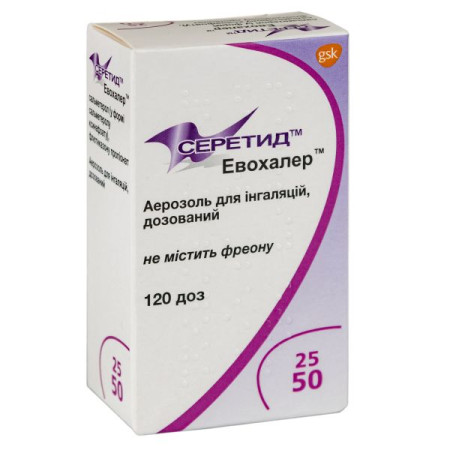Colchicum-Dyspert film-coated tablets 0.5 mg blister No. 20
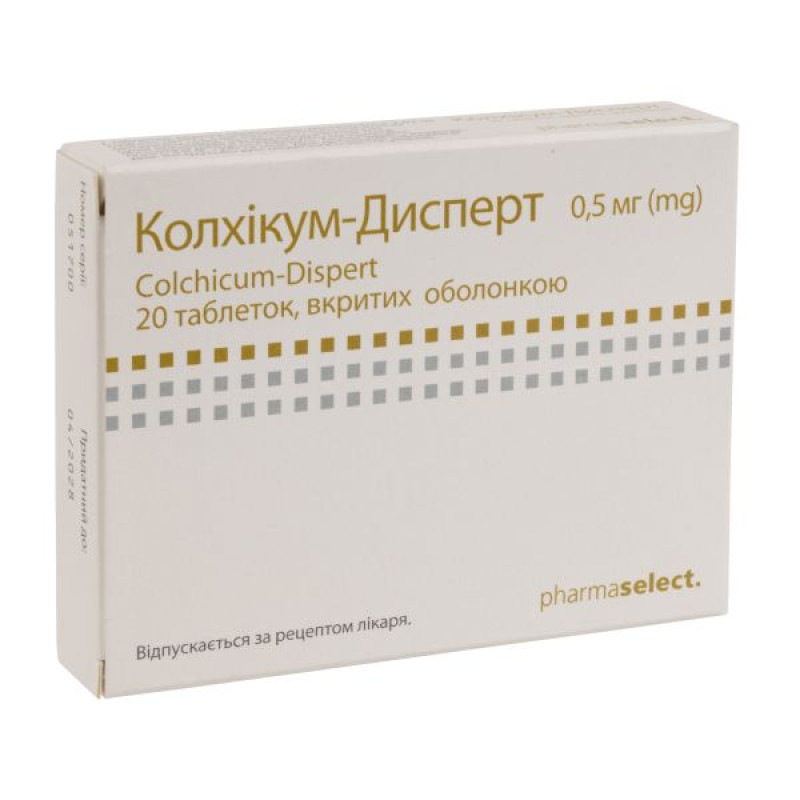
Instructions for use: Colchicum-Dyspert film-coated tablets 0.5 mg blister No. 20
Composition
active ingredient: colchicine;
1 film-coated tablet contains: 0.52–2.42 mg of Colchicum autumnale seed extract (50–150:1), methylene chloride extractant, corresponding to 0.5 mg of the sum of alkaloids in terms of colchicine;
excipients: lactose monohydrate; microcrystalline cellulose; magnesium stearate; talc; copovidone; stearic acid 50; corn starch;
shell: talc, povidone K 29, titanium dioxide (E 171), polyethylene glycols 6000, light magnesium oxide, acacia, sucrose, shellac, croscarmellose sodium, Opalux AS 250000 (sucrose, ponceau 4R (E 124), quinoline yellow (E 104), titanium dioxide (E 171), povidone), carnauba wax.
Dosage form
Film-coated tablets.
Main physicochemical properties: dark red, round, film-coated tablet.
Pharmacotherapeutic group
Drugs used to treat gout that do not affect uric acid metabolism.
ATX code M04A C01.
Pharmacological properties
Pharmacodynamics
Colchicine binds to microtubules during interphase cell division, inhibiting microtubule polymerization and thereby preventing cytoskeletal structure formation, reducing motility and degranulating intracellular lysosomes. Thus, colchicine simultaneously acts as a toxin and reduces the release of lysosomes, chemoattractants and lactic acid.
By acting on leukocytes, colchicine inhibits phagocytosis of uric acid crystals. It disrupts the cell membrane of leukocytes and reduces their mobilization, migration and adhesive capacity. Colchicine reduces the invasion of new granulocytes and inhibits cell division and migration.
Colchicine does not affect the concentration of uric acid in the blood and tissues.
Pharmacokinetics
Absorption
Colchicine is rapidly and efficiently absorbed from the gastrointestinal tract. Approximately 60 minutes after taking 2 film-coated tablets (containing a total of 2 x 0.5 mg of alkaloids, 2 x 0.38 mg of colchicine), a peak plasma level of colchicine of 4.2 ng/ml was recorded.
Distribution
The oral bioavailability of colchicine is 25–50%. In plasma, colchicine is weakly to moderately protein bound (30–50%) and, after reabsorption, is rapidly cleared from plasma and distributed to various tissues.
Colchicine is rapidly distributed in peripheral blood leukocytes, and its concentration in these cells can exceed the concentration in blood plasma after 72 hours (after 15 minutes the concentration is five times higher than the concentration in blood plasma). It has been determined that colchicine has a beneficial effect in the treatment of acute gout by affecting polymorphonuclear leukocytes. Colchicine mainly accumulates in leukocytes, which justifies the beneficial effect of colchicine in gouty arthritis due to inhibition of granulocyte migration to the site of inflammation.
Metabolism and excretion
Colchicine is partially acetylated in the liver and slowly metabolized in other tissues.
The drug and its metabolites are excreted primarily in the feces, with only 10–20% excreted in the urine. The percentage of urinary excretion may be higher in patients with impaired liver function. Due to the high tissue concentration of colchicine, only 10% of a single dose is excreted within 24 hours. Colchicine excretion may continue for >10 days after treatment.
After oral administration of 1 mg colchicine, the mean elimination half-life was 4.4 hours in patients with normal renal function and 18.8 hours in patients with renal dysfunction.
Indication
Adults
treatment of acute attacks of gout;
prevention of gout attacks;
treatment of pericarditis and prevention of recurrent pericarditis;
Behcet's disease.
Adults, children and adolescents
in familial Mediterranean fever to prevent attacks and prevent amyloidosis.
Contraindication
Hypersensitivity to colchicine or to the components of the drug.
Patients with renal or hepatic impairment should avoid the use of colchicine with P-glycoprotein inhibitors or strong CYP3A4 inhibitors due to the increased risk of adverse effects of colchicine. Life-threatening and fatal toxicity of colchicine has been reported in these patients at therapeutic doses.
The drug is contraindicated in patients on dialysis.
Interaction with other medicinal products and other types of interactions
Colchicine may impair the absorption of vitamin B12.
Colchicine is a substrate of CYP3A4 and the transport protein P-glycoprotein.
In the presence of CYP3A4 or P-glycoprotein inhibitors, the concentration of colchicine in the blood may increase.
Life-threatening and fatal drug interactions have been reported in patients receiving colchicine in combination with strong P-glycoprotein and CYP3A4 inhibitors.
If treatment with a P-glycoprotein inhibitor or a strong CYP3A4 inhibitor is necessary in patients with normal renal or hepatic function, a dose adjustment of colchicine may be required. Concomitant use of such inhibitors and colchicine should be avoided in patients with renal or hepatic impairment (see section 4.3).
Concomitant use of atorvastatin, simvastatin, pravastatin, fluvastatin, gemfibrozil or fibrates (associated with myotoxicity) and cyclosporine with colchicine may lead to myopathy. Symptoms usually resolve after discontinuation of use within 1 week to several months.
Concomitant use of colchicine and erythromycin/clarithromycin is contraindicated.
Increased plasma levels of colchicine have been reported with single doses of ketoconazole, ritonavir, verapamil, and diltiazem.
Application features
Colchicine is potentially toxic, so it is important not to exceed the dose prescribed by a specialist with the necessary knowledge and experience.
Patients with renal impairment and cardiovascular disease.
Bone marrow disorders, agranulocytosis, neuromyopathy, myopathy and rhabdomyolysis may occur in patients with renal impairment.
Considerable caution is required in patients with more severe circulatory and renal disorders (dehydration, changes in blood pressure, impaired renal function).
Patients with gastrointestinal disorders.
In patients with gastrointestinal disorders, symptoms may be exacerbated due to the antimitotic effect of colchicine, which leads to diarrhea, nausea, vomiting, and stomach pain.
Treatment of acute gout attacks in patients with renal impairment.
For the treatment of gout attacks, the drug should be used with caution in patients with mild (creatinine clearance 50–80 ml/min) or moderate (creatinine clearance 30–50 ml/min) renal impairment. Patients with moderate renal impairment should have their dose reduced or their dosing interval increased. Treatment of such patients should be carried out under close supervision to avoid side effects.
Patients with severe renal impairment (creatinine clearance less than 30 ml/min) should initially take 1 tablet (0.5 mg) per day. The dosage should be increased under close supervision to avoid side effects. Although the dose does not need to be adjusted for the treatment of gout attacks, patients with severe renal impairment should not have their treatment repeated more frequently than once every 2 weeks. Patients with gout attacks requiring repeated courses of treatment should consider alternative therapy.
Colchicine treatment is contraindicated in patients undergoing dialysis (see Contraindications).
Treatment of acute gout attacks in patients with impaired liver function.
For the treatment of gout attacks, no adjustment of the recommended dose is necessary in patients with mild to moderate hepatic impairment, but close monitoring for adverse effects is necessary. A dose reduction should be considered in patients with severe hepatic impairment.
Treatment of elderly patients.
Colchicum-Dyspert should be used with caution in elderly patients.
For elderly patients, dosage should be selected with caution, taking into account the increased frequency of decreased renal or hepatic function or other concomitant drug therapy.
The drug contains excipients in Opalux AS 250000 that may cause the development of allergic reactions, including asthma, in patients sensitive to these substances.
Patients with rare hereditary problems of galactose intolerance, the Lapp lactase deficiency or glucose-galactose malabsorption should not take this medicine.
Allergic reactions are more common in patients with hypersensitivity to acetylsalicylic acid.
The medicine must be stored out of reach of others before and after use.
Use during pregnancy or breastfeeding
Pregnancy
The drug has not been studied in the treatment of gout attacks in pregnant women, but published data from several studies have shown no evidence of an increased risk of miscarriage, stillbirth, or teratogenic effects in pregnant women using colchicine for the treatment of familial Mediterranean fever. Published data from animal studies on reproductive and developmental effects indicate that colchicine is embryofetal toxic, teratogenic, and alters postnatal development at exposures achieved after use of the drug at or above the indicated therapeutic doses.
Colchicine can be used during pregnancy only in case of urgent need and when it is impossible to replace it with other, safer drugs.
Breast-feeding
Colchicine is excreted in breast milk.
Colchicum-Dyspert should not be used during breastfeeding.
Fertility
Published nonclinical data have shown that colchicine-induced disruption of microtubule formation affects meiosis and mitosis.
The use of colchicine causes morphological abnormalities of sperm and a decrease in sperm count in men, as well as disruption of the process of sperm penetration, the second meiotic division, and egg cell division in women taking colchicine.
Although male infertility due to colchicine is rare, there have been reports of azoospermia after discontinuation of the drug.
Clinical case reports and epidemiological studies in women treated with colchicine have not established a clear association between colchicine use and female infertility.
Ability to influence reaction speed when driving vehicles or other mechanisms
Studies on the effect on the ability to drive and use other mechanisms have not been conducted.
Method of administration and doses
The tablets should be swallowed whole with sufficient liquid, regardless of meals.
Treatment of acute gout attacks should be started as soon as possible (within the first 12 hours of the onset of the gout attack). The expected effect will occur within 12 hours.
First, you should take 2 tablets (1 mg of the drug), then 1 hour later, 1 tablet (0.5 mg of the drug). After that, the tablets should not be taken for 12 hours.
If necessary, the dose can be repeated after 12 hours. The maximum daily dose is 1 tablet (0.5 mg of the drug) every 8 hours until symptoms improve.
The course of treatment should be completed after symptoms have subsided or 12 tablets (6 mg) have been taken. No more than 12 tablets (6 mg) should be taken during the course of treatment.
A repeated course of treatment is carried out no earlier than 3 days (72 hours) after the end of the previous course.
Prevention of gout attacks: Adults should take 1–2 tablets (0.5–1 mg of the drug) per day for up to 6 months. The individual duration of treatment should be determined after assessing factors such as the frequency of exacerbations, the duration of the disease, and the presence and size of tophus.
Treatment of familial Mediterranean fever.
It can be taken as a single dose or divided into multiple doses exceeding 1 mg per day and taken twice a day.
The dosage of colchicine should be increased gradually to a maximum of 3 mg per day to control the course of the disease in the absence of response to treatment with standard dosage. Increasing the daily dose should be done under close supervision to avoid side effects. Close supervision is necessary in the presence of impaired renal or hepatic function. In such patients, the initial dose should be reduced by 50%.
Adults should take 2–6 tablets (1–3 mg of the drug) per day. Most patients require 1–1.5 mg per day, but some patients may require a dosage of 2.0 mg or more.
Children should only take colchicine as prescribed by a doctor and under the supervision of a healthcare professional.
The recommended dose of colchicine for children is:
1 tablet (0.5 mg of the drug) per day for children under 5 years of age;
1–2 tablets (0.5–1 mg of the drug) per day for children aged 5 to 10 years;
2–3 tablets (1–1.5 mg of the drug) per day for children over 10 years of age.
Children with amyloid nephropathy may require higher daily doses: 3 to 4 tablets (1.5–2 mg of the drug) per day.
Treatment of acute pericarditis and recurrent pericarditis.
The recommended daily dose of colchicine for acute and recurrent pericarditis is 1–2 tablets (0.5 mg–1 mg) per day.
In most clinical trials, the dose of colchicine used is 2 tablets (1 mg).
Behcet's disease.
The recommended dose of colchicine is 2–4 tablets (1–2 mg of the drug) per day.
Kidney dysfunction
Use with caution in patients with mild renal impairment. For patients with moderate renal impairment, the dose should be reduced or the dosing interval should be increased. Such patients should be carefully monitored for the occurrence of colchicine side effects. For information on the treatment of patients with severe renal impairment, see section 4.3.
Liver dysfunction
Use with caution in patients with mild/moderate hepatic impairment. Such patients should be closely monitored for colchicine side effects. For patients with severe hepatic impairment, see Contraindications.
Special patient groups
Concomitant use of colchicine with certain drugs, primarily cytochrome P450 3A4 (CYP3A4)/P-glycoprotein inhibitors, increases the risk of colchicine toxicity. If the patient is receiving concomitant therapy with a moderate or potent CYP3A4 inhibitor or P-glycoprotein inhibitor, the maximum recommended oral dose of colchicine should be reduced and the patient should be closely monitored for adverse effects.
Children
The drug is not recommended for use in children under 4 years of age due to insufficient data on use.
Overdose
Colchicine has a narrow therapeutic range and is extremely toxic in overdose. Patients with renal or hepatic impairment, gastrointestinal or cardiac disease, and the elderly are at particular risk of toxicity. Patients with colchicine overdose, even in the absence of early symptoms, should receive immediate medical attention.
Acute intoxication may occur after oral administration of approximately 20 mg (40 tablets) of colchicine in adults and 5 mg (10 tablets) in children. Chronic intoxication may occur after repeated doses of the drug in patients with gout after oral administration of 10 mg or more over several days.
Because colchicine inhibits mitosis, organs with a higher rate of proliferation are more affected.
Symptoms
The exact dose of colchicine that is toxic is unknown. Fatalities have been reported after 7 mg of colchicine for 4 days, while other patients survived after taking more than 60 mg. A review of 150 patients after colchicine overdose found that those who took less than 0.5 mg/kg survived and tended to have milder toxicity, manifested by gastrointestinal upset, while those who took 0.5 mg to 0.8 mg/kg had more serious reactions, such as myelosuppression. There was a 100% mortality rate in those who took more than 0.8 mg/kg.
The first stage of acute colchicine poisoning begins within 24 hours of ingestion and includes gastrointestinal disorders such as dehydration, stomach pain, hemorrhagic gastroenteritis, hypovolemia, diarrhea, nausea, and vomiting, accompanied by electrolyte imbalance, leukocytosis, and hypotension in severe cases.
The second stage, with life-threatening complications, may be accompanied by symptoms such as multiorgan failure, acute renal failure, confusion, coma, peripheral motor and sensory neuropathy, myocardial depression, pancytopenia, arrhythmia, respiratory failure, and coagulopathy within 24 to 72 hours after ingestion.
Death can occur from respiratory and cardiovascular failure.
If the patient survives, recovery of damaged organs may be accompanied by a return of leukocytosis and alopecia, beginning approximately 1 week after the initial overdose.
Therapy
There is no antidote.
In case of colchicine overdose, gastric lavage should be performed, preferably for 60 minutes, and activated charcoal should be administered. Diarrhea does not need to be treated, as defecation is the main route of colchicine elimination.
In adults, vomiting can be induced, for example, with warm hypertonic sodium chloride solution (2–3 teaspoons per glass) or apomorphine (0.1–0.15 mg/kg body weight).
In children under 6 years of age, 1 tablespoon of syrup of ipecac in 100–200 mL of juice is used to induce vomiting, followed by gastric lavage and repeated or continuous administration of activated charcoal.
Hemodialysis is ineffective (due to the large volume of distribution).
Treatment is mainly symptomatic and supportive (control of breathing, maintenance of blood pressure and circulation, correction of fluid and electrolyte balance). Careful analgesia with analgesics and the use of atropine (optional) may be necessary, as well as benzodiazepines, papaverine or tanalbine in case of convulsions. Digoxin may be prescribed to support cardiac function.
Prophylactic antibiotic treatment is recommended. Dexamethasone is indicated for elevated cerebrospinal fluid pressure. Lumbar puncture may also be necessary. Oxygen therapy or mechanical ventilation may be required.
Opiates should not be used!
Hemodynamic, cardiac and respiratory parameters, as well as blood electrolyte levels, should be carefully monitored and controlled.
Side effects
In both short-term and long-term use, the most common adverse reactions in patients initiated on colchicine are gastrointestinal adverse reactions such as diarrhea, which usually occur within 24 hours. Typical symptoms include cramps, nausea, diarrhea, abdominal pain, and vomiting. In the event of severe adverse reactions, the dose should be reduced, as this may lead to greater toxicity. To reduce gastrointestinal adverse reactions, the dose should be reduced during an acute gout attack.
Depending on the frequency of occurrence, adverse reactions are divided into the following categories: very common (≥ 1/10), common (≥ 1/100, < 1/10), uncommon (≥ 1/1000, < 1/100), rare (≥ 1/10000, < 1/1000), very rare (< 1/10000), and also with unknown frequency (cannot be estimated from the available data).
The following are known adverse reactions of colchicine, which are usually reversible after temporary interruption of treatment.
| Blood and lymphatic system disorders | infrequently | bone marrow disorder |
| leukopenia | ||
| pancytopenia | ||
| neutropenia | ||
| thrombocytopenia | ||
| granulocytopenia | ||
| aplastic or hemolytic anemia | ||
| rarely | agranulocytosis | |
| thrombocytosis | ||
| Gastrointestinal tract | often | nausea |
| vomiting | ||
| diarrhea | ||
| abdominal cramps | ||
| abdominal pain | ||
| very rarely | neuropathy | |
| dizziness | ||
| increased sensitivity | ||
| Hepatobiliary system | infrequently frequency unknown | elevated aspartate aminotransferase (AST) levels |
| elevated alanine aminotransferase (ALT) levels | ||
| hepatotoxicity | ||
| Skin and subcutaneous tissue disorders | rarely | alopecia |
| nail damage | ||
| hives | ||
| maculopapular rash | ||
| purpura | ||
| skin rashes | ||
| erythema | ||
| itch | ||
| Musculoskeletal and connective tissue disorders | infrequently | myopathy |
| elevated creatine phosphokinase levels | ||
| myotonia | ||
| muscle weakness | ||
| muscle pain | ||
| rhabdomyolysis | ||
| From the reproductive system | rarely | azoospermia |
| oligospermia | ||
| Renal and urinary disorders | infrequently | kidney failure |
Expiration date
5 years.
Storage conditions
At a temperature not exceeding 25 °C in a place protected from light.
Keep out of reach of children.
Packaging
20 or 25 tablets in a blister; 1 blister in a cardboard box.
Vacation category
According to the recipe.
Producer
Pharmaselect International Beteiligungs GmbH / Pharmaselect Inernational Beteiligungs GmbH.
Address
Ernst-Melchior-Gasse 20, 1020 Vienna, Austria.
There are no reviews for this product.
There are no reviews for this product, be the first to leave your review.
No questions about this product, be the first and ask your question.







